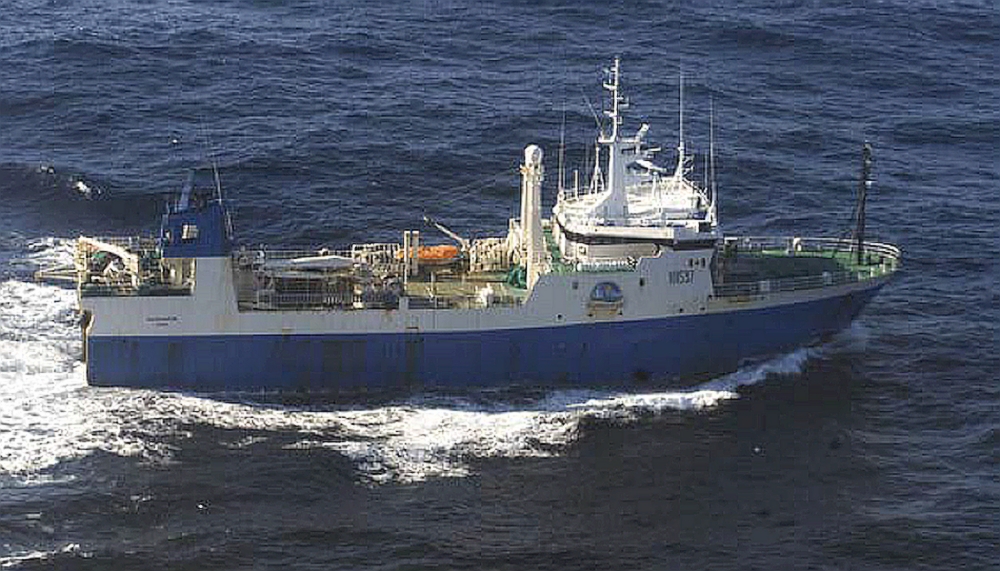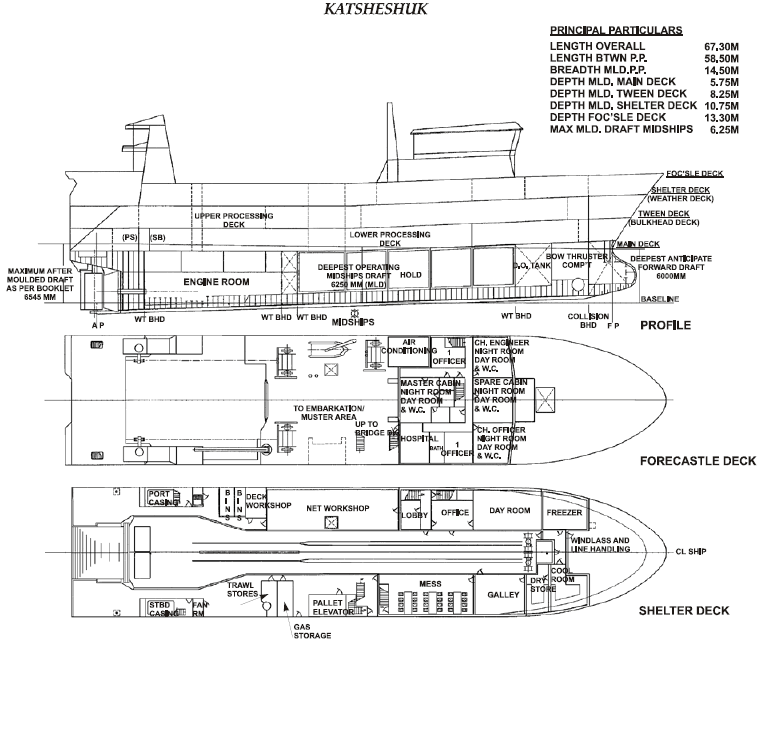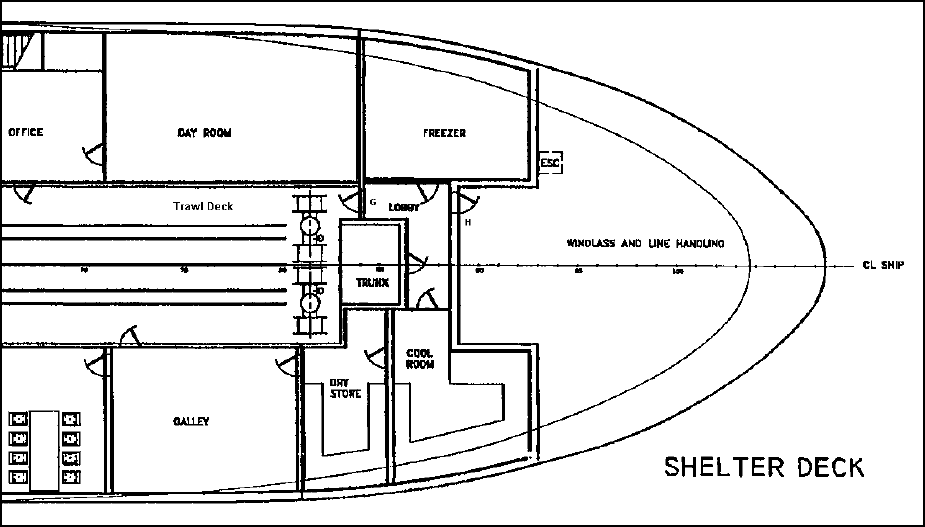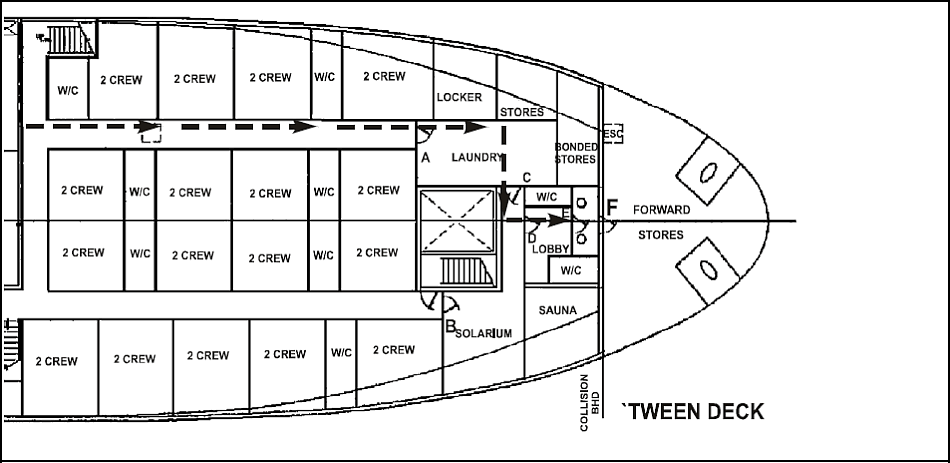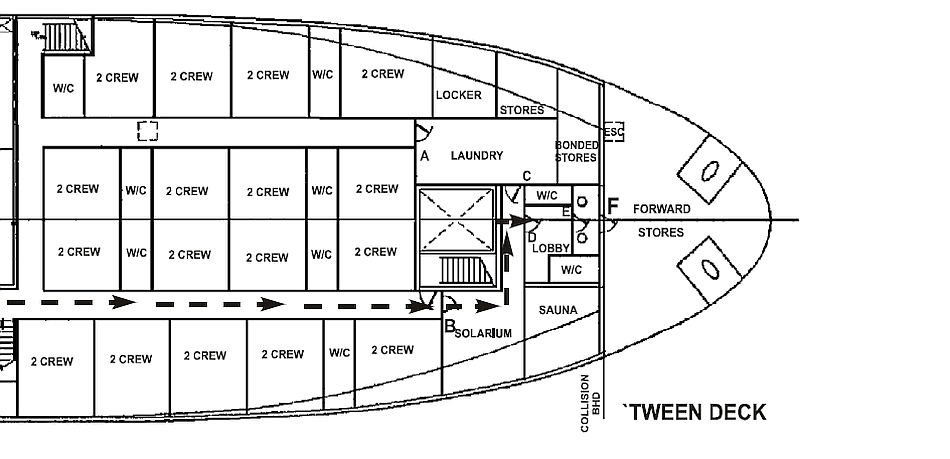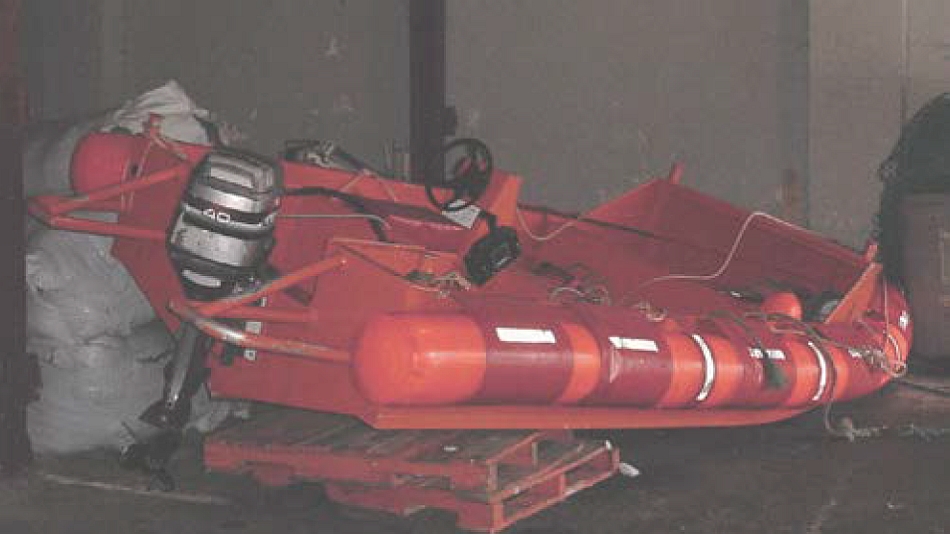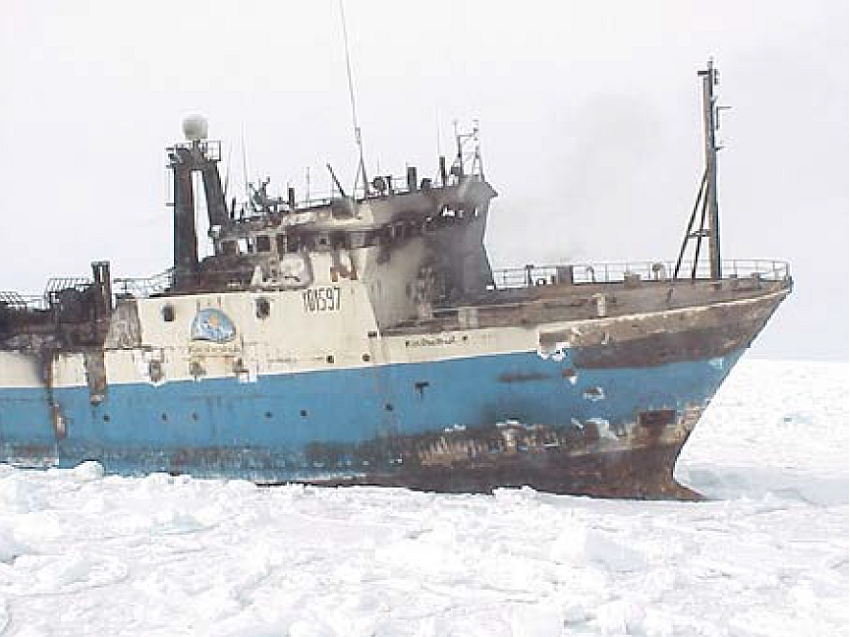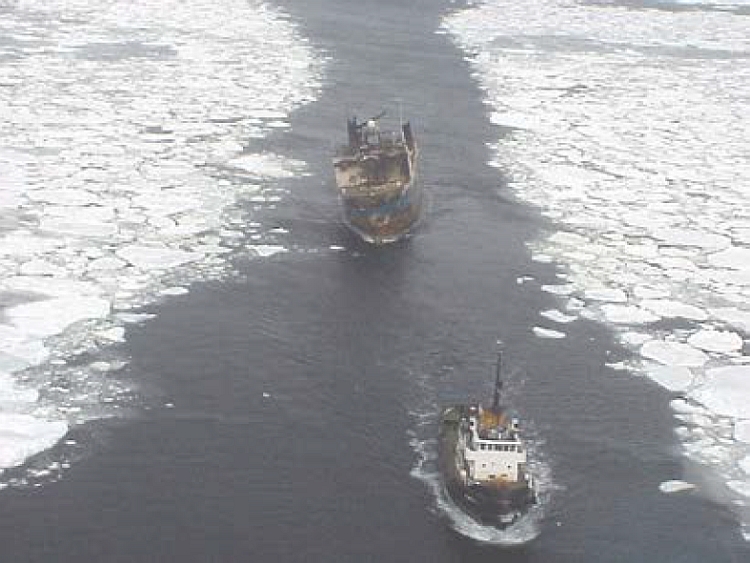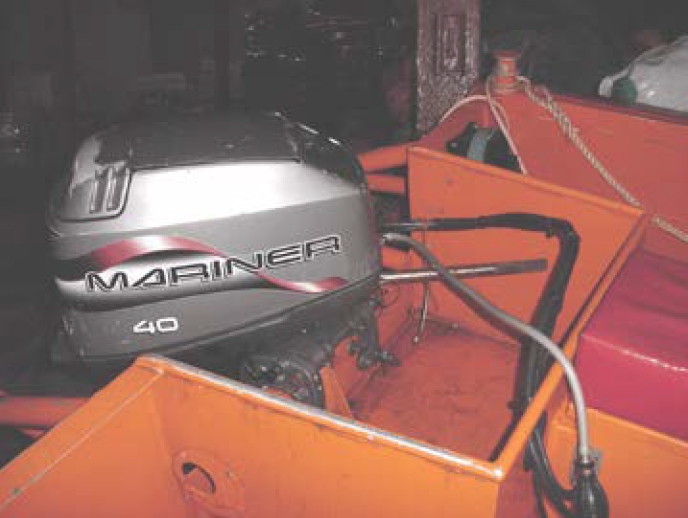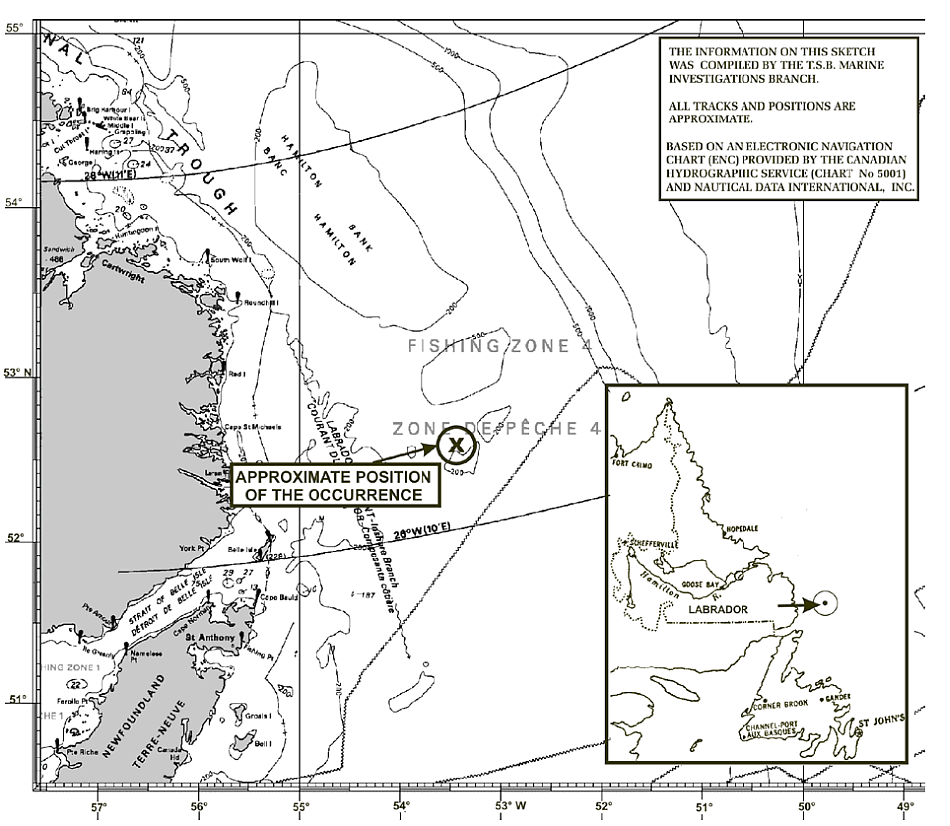Fire and sinking
of the shrimp factory freezer trawler Katsheshuk
Belle Isle, Newfoundland and Labrador 76 nm ENE
The Transportation Safety Board of Canada (TSB) investigated this occurrence for the purpose of advancing transportation safety. It is not the function of the Board to assign fault or determine civil or criminal liability. This report is not created for use in the context of legal, disciplinary or other proceedings. See Ownership and use of content. Masculine pronouns and position titles may be used to signify all genders to comply with the Canadian Transportation Accident Investigation and Safety Board Act (S.C. 1989, c. 3).
Summary
On the afternoon of 17 March 2002, while stopped in ice and waiting for a change in the weather, a fire broke out in the bow of the large fishing vessel Katsheshuk. After an unsuccessful attempt at fighting the fire, the decision was made to abandon the vessel. Several days later, the tug Atlantic Maple took the vessel into tow and steamed towards St. John's, Newfoundland and Labrador. The tug and tow encountered adverse weather and were forced to seek refuge in Trinity Bay, Newfoundland and Labrador. When the weather finally moderated, the tow resumed. On the morning of 30 March 2002, while approximately six nautical miles north-west of Cape St. Francis, Newfoundland and Labrador, the Katsheshuk listed and sank.
Factual information
Particulars of the vessel
| Name | "Katsheshuk" (ex Ice King, ex Atlantic Enterprise) |
|---|---|
| Official number | 808380 |
| Port of registry | Halifax, Nova Scotia |
| Flag | Canada |
| Type | Shrimp Factory Freezer Trawler |
| Gross tonnageFootnote 1 | 2674 |
| LengthFootnote 2 | 64.6 m |
| Draught | 6.25 m |
| Built | Langsten Slip & Batbyggeri A/S, 1987 |
| Propulsion | Caterpillar 3612, 3750 kW |
| Crew | 30 |
| Owner | Katsheshuk Fisheries Limited St. John’s, Newfoundland and Labrador |
Description of the vessel
The vessel was built in Norway in 1987 as a single-screw stern trawler of all-welded steel construction, equipped for on board scallop processing and freezer storage. The navigating bridge and crew accommodation were located forward, the factory was located at midships and the engine room was located aft. In 1988, it was imported to, and registered in, Canada. In 1991, the vessel was converted to a shrimp trawler and was engaged in the shrimp fishery on the East coast of Canada. In 2001, the ship was purchased by the current owner. The hull was subdivided by seven transverse watertight bulkheads, five of which extended from the keel up to the main deck level, while the sixth extended up to the shelter deck as a collision bulkhead. A seventh watertight bulkhead extended from the main deck up to the ‘tween deck and was used to divide the forward freezer hold from the lower processing area. A watertight inner bottom, enclosing double-bottom tanks extended for the length of the fish hold, while the hull in way of the main engine room was of part double-bottom construction (see Figure 1a).
History of the voyage
On 11 March 2002 at 2400,Footnote 3 the Katsheshuk with a crew of 30 sailed from Harbour Grace, Newfoundland and Labrador, bound for the shrimp fishing grounds off eastern Labrador (see Appendix A). On arrival at the destination, the vessel started fishing, but had to move around from area to area to find the shrimp. On the morning of 17 March 2002, poor weather conditions prevented the vessel from fishing, so it steamed on a west-south-west course into the ice pack. At 1200, the vessel stopped in the ice to await better conditions. At approximately 1545, two crew members working on deck saw smoke coming from door G (see Figure 2) in the trawl deck superstructure providing access to the lobby. One crew member immediately went to inform the officer of the watch (OOW) while the other entered the lower accommodation to warn the crew.
The OOW, on being informed of the situation, immediately activated the fire alarm, but it failed to sound. He was soon relieved by the master and proceeded to his muster station. The master then made an announcement on the public address (PA) system and activated the general alarm system, which did sound. The master then contacted three vessels by VHF, the Newfoundland Otter, the Arctic Endurance and the Ocean Pride, which were fishing in the area and informed them of the fire on board the Katsheshuk and requested their assistance. As the master felt he was too busy with the emergency on board, he did not inform the Canadian Coast Guard (CCG) of the vessel's situation.
An initial inspection determined the smoke was emanating from the bow area of the vessel and as a precaution, the sliding watertight doors were remotely closed. While the master monitored the situation from the wheelhouse, in the ‘tween deck accommodation three decks below, preparations were being made to locate and fight the fire.
A fire party was assembled in the after cross-alleyway area of the ‘tween deck accommodation. The fire party consisted of a fire lead wearing only coveralls and a self-contained breathing apparatus (SCBA) and others without SCBAs as a hose party. After a short delay to charge the fire main, the fire party proceeded up the port side alleyway and through the open door A (see Figure 3a) to the laundry room. Leaving the rest of the hose party in the laundry room, the fire lead proceeded into the solarium through door C, latching it open on the way. The fire lead then opened door D and entered a small foyer where he was met by a wall of smoke. On opening either door E or FFootnote 4, he was met with heat and flame and immediately opened up his hose in a straight stream pattern. He was only able to direct water on the fire for a few seconds before the rest of his fire party (with no SCBA) called for him to pull back. The fire lead, by now running low on air, dropped the hose in the laundry room and retreated to the cross-alleyway area leaving some doors in the open position.
While up forward and unknown to the first fire party, a second fire party was being assembled in the starboard alleyway (see Figure 3b). This team consisted of a fire lead wearing jeans, a short sleeve shirt and a SCBA accompanied by a hose party. As the first fire party was pulling back, the second fire party opened door B leading to the solarium and the fire lead felt some heat. He introduced water into the solarium for about a minute before deciding to pull back to get a safety line. On the second trip forward, the fire lead made it to door D and when he opened it, a white flame shot out over his head and hit the deckhead. He opened up his hose at the fire, but was quickly forced back by debris falling from the deckhead. The second fire party then retreated to the after cross-alleyway also leaving some doors in the open position.
Forced to give up their plan of fighting the fire internally, the crew started to set up boundary cooling on the exterior of the vessel. To cool the deckhead of the forecastle storage locker, a fire hose was fed through the wheelhouse, onto the foredeck, and then lowered through a rope scuttle (an opening through which mooring ropes are passed) to the forward mooring station. Shortly after charging the line, a hose clamp securing the hose to the hose fitting let go, requiring the line to be shut down to reattach the clamp. A second fire hose was set up on the trawl deck and directed at the transverse bulkhead at the forward end of the trawl deck. Meanwhile, the master contacted other vessels in the area and requested additional fire-fighting equipment. Some hoses and SCBAs were transferred to the Katsheshuk from other vessels, however the hose connections were incompatible and an adapter had to be made for one of the Katsheshuk hydrants.
At approximately the same time and roughly 45 minutes after the fire was discovered, the master decided to evacuate all non-essential personnel to the other fishing vessels in the area. An attempt was made to raise the vessel's rescue boat (see Photo 2) using the port boat davit, but the crew could not get it to operate. As a result, they used the cargo crane on the starboard side. The crew evacuated using the vessel's own rescue boat by boarding the rescue boat on the forecastle deck and then being lowered to the water.
After several lifts, it was decided to deploy the pilot ladder and have the crew climb down the ladder and board the rescue boats from the Katsheshuk as well as those dispatched from the nearby vessels. During the initial evacuation, 24 crew members were transferred to the Arctic Endurance and Newfoundland Otter. As darkness approached, two more crew members were evacuated from the vessel.
Over time the vessel started to develop a list, so one crew member donned a fireman's outfit with SCBA and entered the ‘tween deck accommodation to shut off the fire hoses which were believed still to be open in the port and starboard alleyways. The port fire hose was found to be shut-off while the starboard fire hose was found to have burst. The hydrant feeding the starboard fire hose was closed and the crew member retreated from the ‘tween deck accommodation.
Eventually, the wheelhouse began to fill with smoke, and the decision was made by the master for the remaining crew members to leave the vessel. All main and auxiliary power was shut down and the four remaining crew members donned immersion suits and prepared to abandon the vessel. A liferaft was thrown over the side and inflated for use as a temporary shelter. While descending the pilot ladder, at least two crew members fell off. One fell onto the ice and suffered a broken foot while the second fell into the water but was quickly recovered. During the final evacuation, these four crew members were transferred to the Arctic Endurance. Approximately 3 hours and 45 minutes after the onset of the fire, the Newfoundland Otter made the initial notification of the occurrence to the CCG through the Marine Communications and Traffic Services (MCTS) at St. Anthony, Newfoundland and Labrador.
Injuries to persons
One crew member suffered a broken foot when he fell off the pilot ladder. A second crew member suffered a lacerated hand when he came in contact with some broken glass while retrieving a fire axe.
Salvage
The owners of the Katsheshuk hired the tug Atlantic Maple to tow the vessel to port. By the time the tug arrived on the scene, the now derelict vessel had drifted approximately 168 nautical miles to the south. On the morning of 26 March 2002 (see Photo 4), the Atlantic Maple escorted by the CCGS Henry Larsen took the Katsheshuk under tow. The original plan was to tow the vessel directly to St. John's Newfoundland and Labrador, but due to high winds, the tug and tow were forced to seek shelter in Trinity Bay and later Conception Bay.,
On the early morning of 30 March 2002, weather conditions were favourable and the Atlantic Maple, with the Katsheshuk in tow, resumed its passage and headed for St. John's. At approximately 0616, the Atlantic Maple noticed the Katsheshuk had taken on a pronounced list and appeared to be settling lower in the water. At 0726, the Katsheshuk sank in position 47°54.3′ N, 052°49.5′ W (see Appendix B).
Damage to the vessel
The vessel sank and was subsequently declared a total loss.
Damage to the environment
When the vessel sank, the action of the wind and the waves dispersed the oil and its impact on the environment was considered minimal.
Vessel certification
The Katsheshuk held the class 1A1 Stern Trawler KMC ICE-1AFootnote 5 with Det Norske Veritas at the time of the occurrence. It was also subject to regular inspection under the Transport Canada Marine Safety Large Fishing Vessel Inspection Regulations. The vessel was certificated and equipped in accordance with Canadian regulations and was last issued a Safety Inspection Certificate (SIC 31) on 29 March 2001.
Personnel certification
The master and the officers of the vessel were in possession of valid certificates for their positions and the trade in which they were engaged. All of the officers and most of the crew had some level of Marine Emergency Duties training.
Personnel history
The master had 27 years experience at sea and approximately seven years experience as master on various fishing vessels.
Weather information
The weather conditions at the time of the occurrence were estimated at winds from the north-northwest at 50 knots with a swell of 4 m. At the time of the sinking, the winds were from the northwest at 15 to 20 knots with a sea height of 1.5 m.
Forward stores
The forward stores was located in the forepeak on the ‘tween deck level. It was surrounded by the hull on two sides, the forepeak tank and chain locker underneath, the forward mooring area overhead and a steel bulkhead aft. It was thermally insulated in way of the hull and was heated by a 5 kWFootnote 6 (440 Volts AC) unit heater suspended from the deckhead. Although there was a sign posted indicating the door was "to be closed at sea", this weathertight door as well as an overhead escape hatch from the compartment were generally left open. Various sundries which were stored in the locker included bedding (pillows), toilet paper, paper towels, cardboard, cleaning supplies, various aerosols, Christmas decorations, charcoal briquets, and barbecue lighter fluid. The physical tidiness was characterized as messy. The day before the fire, several crew members were tasked to clean up the storage area. After this work was completed, the physical tidiness was described as better.
Forward mooring station door
The door H (see Figure 2) leading from the shelter deck lobby to the forward mooring area was normally left open.
Boat and fire drills
Boat and fire drills were carried out on a regular basis. These drills would typically involve the crew mustering at their designated emergency stations and stating their respective duties. It was a usual practice for the crew to try on their immersion suits, as well as check and lubricate the zippers. Familiarization with and donning of the SCBAs was also common. None of the crew, however, could recall having ever witnessed the fire hoses being run out and charged during a fire drill. There was also no indication that fire drills were conducted with mock scenarios to fully familiarize the crew with the equipment and foster better interaction and coordination between team members.
Fire detection system
The vessel was equipped with an automatic fire detection system connected to remote sensors fitted through the vessel. In the event of fire the sensor would detect the smoke or heat and send a signal (pre-alarm) to the wheelhouse. The wheelhouse personnel could either acknowledge the signal and investigate its cause, or immediately activate the fire alarm. Typically, if the pre-alarm was not acknowledged within a preset time, the fire detection system would automatically activate the fire alarm. Fire and general alarm systems are generally integrated with the PA system to permit the temporary silencing of the alarm during an announcement.Footnote 7 On completion of the announcement, the alarm automatically resumes sounding.
Analysis
Failure of the fire detection system
Immediately on being notified of the fire, the OOW manually activated the fire alarm system. He was soon relieved by the master and left the wheelhouse for his muster station. The master soon realized that the fire alarm had not sounded, and picked up the PA microphone to make a general call. He simultaneously activated the general alarm. On completion of his PA announcement, the general alarm started to annunciate.
The sinking of the vessel precluded her examination. Consequently, the precise cause for the fire detection system failure could not be established. However, the most probable scenarios are as follows:
- A fault in the automatic fire detection system prevented it from detecting the fire and actuating the pre-alarm and the fire alarm.
- A momentary fault in the PA system overrode the alarm systems and prevented them from sounding. The fault cleared itself when the master used the PA system.
Delay in notifying the authorities
Between the time the fire was detected at 1545, and the time an initial notification was made to the MCTS at 1925, almost 3 hours and 40 minutes had elapsed. The master indicated that he didn't think it necessary to contact the MCTS as there were three other vessels in the area. He was also very busy in the wheelhouse with his own emergency duties.
Instances are on record where appropriate authorities are not notified of the emergency in a timely manner. In another occurrence involving the F/V Fame, the authorities were not notified until some 14 ½ hours following the emergency.Footnote 8 The escalation of the emergency and the eventual notification of the authorities has the potential to compromise the safety of personnel as well as the safety of the vessel. Given that the success of a search and rescue (SAR) mission is dependent upon the prompt and efficient dispatch of SAR resources, it is essential that the authorities be notified as soon as an emergency situation arises. This permits the SAR authorities to identify, prepare and dispatch appropriate units and equipment in a timely manner in the event the emergency escalates and/or SAR assistance is required/requested. By not notifying SAR, the vessel as well as the shipboard personnel are placed in a vulnerable situation. In the event that the emergency is brought under control and assistance from the authorities is no longer required, the resources could then be stood down.
In August 2001, a Ship Safety Bulletin (No. 06/2001) was issued entitled Global Maritime Distress and Safety System (GMDSS) and Guidance on Important Operational Procedures. This bulletin, inter alia,provides guidance to masters in distress situations and emphasizes the importance of alerting search and rescue authorities at the earliest possible moment in any situation that may involve a danger to life or has the potential of developing into such a situation. To help ensure this information would be readily available to mariners, Transport Canada also arranged to have this information published in the CCG's Annual Edition of the Radio Aids to Marine Navigation.
Location of the fire
The first fire party lead opened door D and entered a small foyer where he was met by a wall of smoke. Upon opening either door E or F, he was met with heat and flame. The second fire party lead made it to door D and when he opened it, he was met by a white flame which shot out over his head and hit the deckhead. Door D provided access to the compartment which housed the spurling pipes and door F provided access to the forward stores. This would suggest that the fire originated either in the compartment housing the spurling pipes or in the forward stores.
There is no information to suggest that the compartment which housed the spurling pipes had combustible materials and a source of ignition.
The housekeeping practices in the forward stores were poor. The supplies were stored both on deck or on shelving and were not secured. As such they were prone to being dislodged from their position due to the movement of the vessel in the 50-knot winds and 4-metre swell. Further, materials stored in the locker included: flammable material such as barbecue lighter fluid; chemicals/cleaning materials that in enclosed places have the potential to generate toxic fumes; and combustible materials such as paper products; all of which provided a source of fuel to the fire.
The temperature in the forward stores was such that the doors were always kept open. Given that the space had a 5kW heater unit and that the compartment contained materials that are readily ignitable, it is highly likely that the fire originated in this compartment.
Cause of the fire
As the vessel ultimately sank, the cause of the fire could not be determined.
Boat and fire drills
The vessel was a recent acquisition in late 2001 and Boat and Fire Drills were carried out on a regular basis. However, due to the short period the crew was on board this vessel (3-4 months), relatively fewer drills had been performed. However in spite of the regulatory requirements,Footnote 9 there was no indications that any fire hoses were ever run out, inspected and pressurized. A process that inspects and pressurizes hoses on a periodic basis as required by the regulations would permit the detection of deficiencies in a timely manner and would provide an opportunity to rectify the defect.
The fact that no mock scenarios were used during the fire drills meant that when faced with a real life situation, the crew, although Marine Emergency Duties trained, was not completely familiar/comfortable with the duties at hand. As a result the crew was ill-prepared to put forward a cohesive and co-ordinated fire-fighting response.
Fire fighting
The fire-fighting effort, while well intentioned, was ill-advised and poorly executed. A review of the Fire Drill Muster List indicated that the crew did not proceed to the designated emergency stations. Instead, each crew member reacted to the emergency situation and took upon themselves different roles leading to an uncoordinated response. This culminated in neither of the fire party leads (port or starboard) being properly attired with SCBA and protective fireman's outfit to fight the fire and both had to retract from the fire scene. In this instance, a fireman's outfit was at hand for use by the port fire hose party but none was readily available for the starboard fire hose party's use. The vessel was outfitted with two complete sets of SCBAs and fireman's outfits and one fireman's outfit was not available for use. The non-availability of one of the fireman's outfit for use may be attributable, in part, to personnel not adhering to the designated fire stations culminating in it being moved to a different location during fire-fighting activity.
Given that the vessel carried two sets of SCBAs and two fireman's outfits, a single fire team in full protective gear and SCBAs would have been better prepared to fight the fire with a greater chance of success.
Fire containment
The fire is believed to have started in a relatively small compartment,Footnote 10 but quickly breached the compartment and ultimately consumed the entire vessel. The largest obstacle faced by the crew in attempting to fight the fire was the fact that many doors and hatches were open before the fire started, and even more were left open after the internal firefighting attempt was abandoned. In so doing, the fire progressed aft to the ‘tween deck accommodation through the open collision bulkhead watertight door. The exact number is not known, but it was determined that several doors in the forward area of the ‘tween deck accommodation were left open after the initial fire-fighting attempt failed. The open escape hatch from the forward storage locker allowed smoke to ventilate out to the forward mooring area, while an open door from the forward mooring area to the shelter deck lobby allowed smoke to flow into the lobby.
The uncoordinated effort to fight the fire in conjunction with failure of some of the fire-fighting equipment further hampered fire-fighting activity. After being forced to abandon the attempt to fight the fire internally, the crew set up boundary cooling at four locations. One at the ‘tween deck port side alleyway forward, a second at the ‘tween deck starboard side alleyway forward, a third at the shelter (trawl) deck bulkhead forward, and a fourth on the forward shelter deck (storage locker deckhead). Although two areas of boundary cooling had been set up in the ‘tween deck accommodation, it was discovered just prior to the final evacuation of the vessel that the port hose was shut-off and the starboard hose had failed (burst). Additionally one of the hoses supplying water to the forward shelter deck area failed when a hose clamp let go, requiring its repair.
Running low on equipment , the vessel requested additional fire-fighting equipment from the other fishing vessels in the area. When the hoses were brought on board, it was discovered that the connections on the borrowed hoses were incompatible with the fire system (hydrants and hoses) on the Katsheshuk. This required the vessel's crew to quickly make up an adapter for one of the fire hydrants.
In this instance, appropriate measures were not taken to contain the fire; containment of a fire being one of the factors that will positively influence the outcome of the fire-fighting effort. The closing of all doors would have enhanced the fire containment effort with a greater chance of success. The containment of the fire together with the boundary cooling would have provided an opportunity for the fire to burn itself out.
Evacuation of vessel
Once conditions precluded fighting of the fire internally, the decision was made to evacuate all non-essential personnel. Initially the crew evacuated using the vessel's own rescue boat and those of nearby vessels. The crew would board the RB on the forecastle deck and then be lowered to the water by use of the starboard cargo crane. The number of personnel evacuated using the vessel's own rescue boat was reduced owing to the fact that the craft required two crew to operate it. An estimated four personnel transfers were carried out in this manner. Fearing a loss of power, the decision was then made to use a general purpose pilot ladder. The use of a pilot ladder required the crew to climb down the ladder to a rescue boat waiting alongside the vessel. From all accounts the starboard pilot ladder was in an unsatisfactory state with many loose or missing wooden rungs. Compounding the condition of the pilot ladder was the fact that the lower end was continually being hooked by the ice floes, causing the ladder to twist. Two crew members fell from the starboard pilot ladder during the evacuation.
Rescue boat
The Katsheshuk had a 5.4 m rescue boat equipped with a 40 HP outboard motor which formed part of the vessel's safety equipmentFootnote 11. The remote steering control on the rescue boat was reported to have been unserviceable since mid-January 2002. To allow for steerage, an improvised tiller arm (see Photo 5) had been jury-rigged to the outboard motor. This ad-hoc arrangement required the rescue boat to have two operating personnel, one to steer the vessel and a second to operate the throttle.
The operational issues with the port boat davit during the evacuation could not be determined.
Findings
Findings as to causes and contributing factors
- The fire most likely started in the forward stores and the cause of the fire could not be determined.
- The fire-fighting effort was uncoordinated and ineffective in that:
- several crew members did not carry out their emergency duties in accordance with the posted emergency duties plan;
- several doors were left in the open position some prior to and others following cessation of the fire-fighting activity;
- members of both fire hose teams were inadequately equipped (dressed) to fight a fire; and
- some fire-fighting equipment failed to operate as necessary.
Findings as to risk
- The 3 hour and 40 minute delay in notifying authorities of the emergency precluded timely dispatch of search and rescue resources.
- Although required to by regulations, the fire hoses were not tested. This precluded the detection of deficiencies in a timely manner and the loss of opportunity to rectify them.
- The unsatisfactory condition of the starboard pilot ladder hampered the abandonment process and culminated in some of the crew sustaining injury.
- The practice of routinely keeping open the emergency escape hatch from the forward stores, the weathertight door to the forward stores and the access door from the mooring station to the shelter deck lobby is unsafe and risky.
Other findings
- The steering control for the rescue boat had been unserviceable for two months at the time of the occurrence.
Safety action
Safety concern
Adequacy of boat and fire drills on fishing vessels
The Transportation Safety Board of Canada has already recognized the issue of preparedness and efficiency in drills. Recommendation M94-07, "Fire and Boat Drills on Fishing Vessels" recommended that Transport Canada ensure that the safety intent of the Boat and Fire Drill Regulations is being fulfilled by owners and operators of fishing vessels. In response, Transport Canada issued Ship Safety Bulletin 13/1999, titled "Muster Lists and Practising of Emergency Procedures", reflecting the intent of drills, in that knowing what to do and being prepared for an emergency increases everyone's survivability and proves the equipment and the ability of crew.
Boat and fire drills carried out on a regular basis, in accordance with the regulations, familiarize the crew in dealing with an emergency situation that may develop on board a vessel. In accordance with the intent of the Boat and Fire Drill Regulations, drills on board vessels like the Katsheshuk are to be carried out monthly, and the crew is to be familiarized and instructed with respect to the facilities of the vessel and their duties. Each crew member is to demonstrate such familiarity. Such drills include, inter alia, the running out, examination and pressurization of fire hoses, examination of smoke helmets, breathing apparatus and associated firefighting equipment, etc.
Drills, therefore, improve crew efficiency, but also ensure the verification, testing and functionality of the equipment. The use of realistic scenarios while drills are conducted augments the level of preparedness, readiness and effectiveness.
The Board is concerned that, despite efforts to improve the familiarity with equipment and competence of fishing vessel crew members in emergency situations, accidents like that on the Katsheshuk continue to put vessels and their crews at risk. The Board will continue to monitor these issues and will determine further safety action as required.
This report concludes the Transportation Safety Board's investigation into this occurrence. Consequently, the Board authorized the release of this report on .
Appendices
Appendix A - Sketch of the occurrence area
Appendix B - Sketch of the sinking area
Appendix C – Glossary
- AC
- alternating current
- CCG
- Canadian Coast Guard
- CCGS
- Canadian Coast Guard Ship
- kW
- kilowatt
- MCTS
- Marine Communications and Traffic Services
- OOW
- officer of the watch
- PA
- public address
- SAR
- search and rescue
- SCBA
- self-contained breathing apparatus
- SIC
- Safety Inspection Certificate
- TSB
- Transportation Safety Board of Canada
- VHF
- very high frequency
- m
- metre
- °
- degree
- ′
- minute
